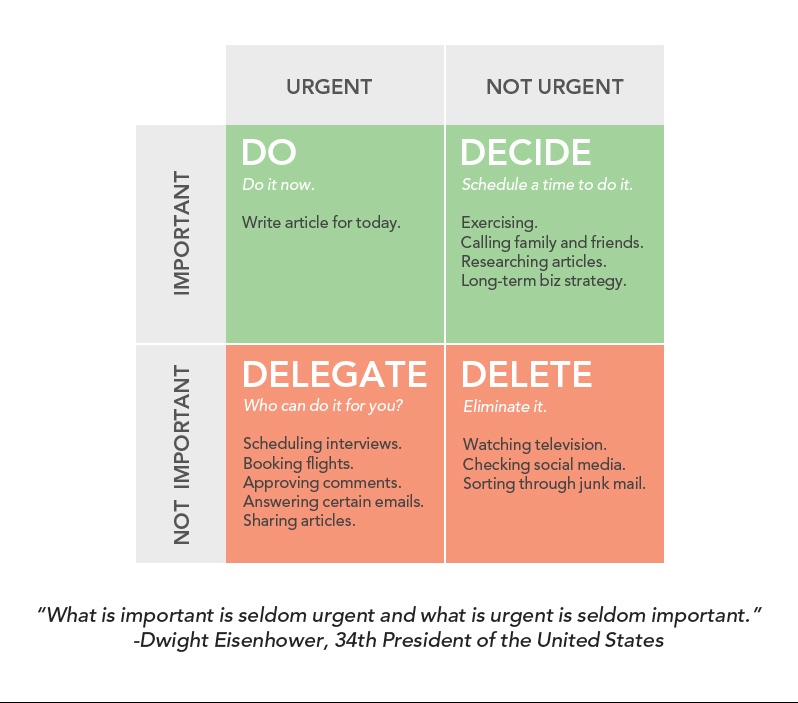The Eisenhower Matrix is a task prioritization technique that could be the answer to your overloaded to-do list and notification nightmares.
You’ve got a lot on your plate. In addition to your actual projects, it feels like you also have 50 other little tasks that demand your attention. There are a ton of unanswered emails in your inbox. A coworker on another project desperately needs your input on something, and they’re on a deadline. Not to mention that overflowing laundry bin waiting for you at home.
With all of these priorities whizzing around your brain simultaneously, it’s hard to actually tackle any of them. The anxiety of not knowing where to start is leaving you in a state of analysis paralysis.
You feel overwhelmed, and stuck. And if you don’t have a time management method, it’s easy to fall into the trap of thinking that every task is urgent and important.
But it’s not all bad news. Solutions for prioritization and decision-making are not new. In fact, one of the greatest frameworks for decision-making and time management came over a half a century ago, from old school productivity master and very busy fellow Dwight Eisenhower, 34th President of the United States.
During his presidency, President Eisenhower managed Cold-War tensions, ended the war in Korea, and created the Interstate Highway System among many other achievements. You could say he was a very busy fellow, and thankfully he left this productivity legacy to help you free yourself from hurry worry and the anxiety to complete all your activities within a day.
The Eisenhower Matrix
The Eisenhower Matrix (or Eisenhower Box) is an easy, yet extremely effective way to figure out how to prioritize your tasks so that the most important don’t fall by the wayside to the sudden, unexpected, and urgent ones.
Here’s a quick video tutorial for how to organize your tasks into the do, delegate, decide and delete buckets:
The idea is that all of your tasks can be sorted into four quadrants, with axes of Important and Urgent on either side. These four quadrants are given number values of 1 through 4 based on their priority.
 Image credit: Jamesclear.com
Image credit: Jamesclear.com
- “Important” and “Urgent” tasks. These receive a priority level of 1 and should be your primary focus to complete.
- “Important”, but “Not Urgent” tasks. These are the long-term goals and tasks that you are important to you personal and professional development, but don’t have a firm deadline.
- “Not Important”, but “Urgent” tasks. These tasks are the ones you can delegate or schedule to complete after your 1st quadrant tasks are completed.
- “Not Important” and “Not Urgent” tasks. These tasks are placed in the 4th quadrant ones you put to wayside and should eliminate. Do you really need to binge-watch Season 1 of This Is Us or could that time be better used to work on your 2nd quadrant tasks, such as reading one new book per month?
The Eisenhower Matrix is a simple framework that helps you break out of that pernicious analysis paralysis which occurs every time you “feel like you don’t even know where to start.” By assigning each task to a quadrant, it is easy to understand what actually requires your attention this very second and what can wait until another day.
Most importantly, the matrix helps you focus on your long-term goals by clearing out the distracting shallow work that keeps you from exercising, learning how to code, or other large projects that require more time to accomplish, but ultimately improve your life and career.
Why Is It Hard To Make Decisions?
Research shows that decision-making is inextricably tied to emotion. The part of your brain linked to rationality and decision-making, the orbitofrontal cortex, and the part of your brain associated with emotion, the amygdala, are often working together when you are processing higher thought.
This means that decision-making is actually tied to mood regulation. Indeed, anxiety and depression are often categorized as feelings of immobility, being stuck, and an inability to make decisions.
That’s why adopting a framework like the Eisenhower Matrix to help you triage your tasks, or decisions you need to make, is an easy way to reduce your emotional load.
By practicing the Eisenhower Matrix regularly, your brain will begin to rewire itself and you’ll easily get into the habit of quickly identifying the difference between important tasks and non-important tasks.
Make It Visible
The Eisenhower Matrix can be translated into a Trello board of your tasks. Make a list for each quadrant, as well as an “Incoming” list where you can dump everything you need to do, and triage when you’re ready. It will look something like this:
Just looking at your board will give you the visual ease of load balancing. Do you have a lot of cards in the Not Important/Urgent list? Start tackling little things on there to make those lists seem more manageable. These activities could include writing and responding to a batch of emails in one hour, or topping up your social media queue with tweets and Facebook posts for the week.
Only put what is truly pressing in the Important/Urgent list. These are tasks that simply cannot be put off, and for which you must give your undivided attention. By identifying these activities, you can schedule blocks of time during your day to hone in and do deep work to complete them more efficiently.
Tasks that are Urgent but not necessarily Important are often tasks that can be delegated to someone else when appropriate. Remember that assigning priority to tasks means different things to different people. For you, scheduling that flight for the conference might be urgent because if you don’t do it in advance, airline fares will break your budget. For others, that might be a task that is better delegated to an assistant.
If you collaborate closely with someone, like an assistant or a spouse (depending if it’s a work or home to-do list), add them to the board so you can assign them some of those tasks.
If you want to keep this board to yourself, use the copy card function to move those delegated tasks to another board where you are collaborating with others.
Fun fact: President Eisenhower was a master delegator. He created the position of the White House Chief of Staff.
Automate What Comes Into The Matrix
Part of the anxiety of having multiple tasks is not being able to see them all in one place. If you’re in your email and you see something you need to answer but don’t have the time, use Trello’s email-to-board feature to forward this automatically to the Incoming list. After a few of these pile up, you know it’s time to triage those cards into their Eisenhower categories.
If you work across a few Trello boards, you can attach a card or a board to another card with the related cards feature. At a glance, you can get key information from other projects, such as due dates and checklists, in your own matrix so you can manage your progress to your heart’s content without changing your team’s own Trello organization process.
You can also use automation tool Zapier to create cards in your Incoming list. Connect other apps you’re using to Trello, and when specific events happen, it will trigger a Zap and send a card to your Trello list.
For example, automatically create a Trello card every time a new row is created in a Google spreadsheet. Or if you’re on the go and jotting notes down in Evernote, set them to Zap to your Trello board so that they can be turned into action items later.
And don’t forget that you can also simply add cards from other Trello boards into your Eisenhower Matrix by using the Copy function under Actions listed on each card.
Drop The Dread Of Decision Making
The Eisenhower Matrix is a visual framework that can be used with productivity tools you’re already in, like Trello, to keep everything organized. It’s an easy way to batch tasks into four priority levels, one of which (Not Important/Not Urgent) is immediately dropped, so really it’s only three categories of attention-worthy tasks to focus on.
All you need to do is spend time analyzing your tasks and goals and categorize them into activities that you can be completed within certain time frames. Through this method, your prioritization and delegation skills will become top-notch.
In short, you’ve already got plenty on your plate. Don’t make the process of prioritization yet another thing you need to deal with. Thanks, Ike!









































